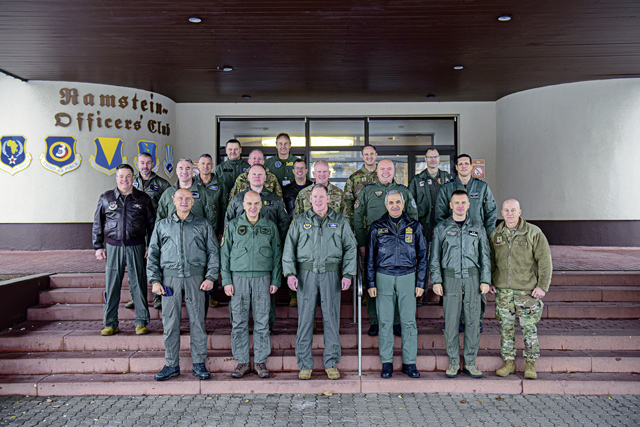
High-ranking military officials convened Monday at Ramstein Air Base for the Fall 2023 F-35 Air Chief Symposium.
U.S. Air Force Gen. James B. Hecker, Commander of United States Air Forces in Europe-Air Forces Africa and NATO Allied Air Command, chaired the gathering as a platform for high-level updates and collaborative discussions to shape the future course of integration of fifth-generation aircraft into Allied and partner operations.
“The symposium aimed to align our perspectives on shared concerns, chart a course for future endeavors, and explore the potential of fifth-generation fighters in deterring threats,” said General Hecker. “These aircraft enhance survivability and lethality through cutting-edge technologies and advanced systems.”
Countries in attendance included the United States, Belgium, Canada, Denmark, Finland, Germany, Israel, Italy, Netherlands, Norway, Poland, Switzerland, and the United Kingdom.
The meeting served as a platform for Air Chiefs and officials to engage in constructive dialogue, pooling together their expertise and experiences.
At the core of the discussions laid a crucial focal point: the concept of cross-servicing agreements.
CSAs allow nations to leverage foreign airfields and maintenance resources for landing and servicing their aircraft if needed, extending capabilities beyond a nation’s own territorial confines.
“The significance of the cross-servicing agreements cannot be overstated, especially in the context of agile combat employments, enabling seamless cooperation and collaboration between allied and partner nations,” said Mr. Brendan Andrus, F-35 Program Analyst. “CSAs also maximizes interoperability by enabling any F-35 to land at any F-35 base, regardless of nation, and refuel, repair, rearm, and return to the fight.”
The F-35 program consists of eight partner nations, including the United States and nine foreign military sales nations. Currently, six European nations operate the F-35 on home soil, lead by Italy in 2015 and followed by Norway, Israel, the Netherlands, United Kingdom, and Denmark.
USAFE-AFAFRICA marked a significant milestone with the reception of its inaugural F-35 delivery to RAF Lakenheath in the United Kingdom in 2019.
Belgium, Finland, Germany, Poland, and Switzerland will receive their first aircraft by 2030.
In 2022, the momentum towards acquiring F-35 aircraft gained further traction with Germany agreeing to procure F-35s.
“In this ever-evolving security landscape, the reality remains clear; we cannot fight alone. Integration and interoperability stand as imperative pillars, essential to our collective strength and deterrence,” said Andrus.
The increasing number of nations obtaining F-35s in Europe signals a noteworthy trend, fostering expectations that the region will host over 600 operational F-35s by 2030.
“Collaborating closely with allied partners, the U.S. Air Force has gained significant insights from operationalizing the F-35,” said Hecker. “These insights form the foundation for discussions among air chiefs and are instrumental in devising strategies to enhance interoperability levels among European F-35 fleets. This leverages the wealth of knowledge accumulated in recent years.”
The incorporation of the F-35 into NATO’s framework marks a significant milestone in the Alliance’s evolution. The deployment of F-35s not only signifies a technological leap with the inclusion of a formidable fifth-generation aircraft but also strategically positions these assets across the European theater.
The presence of the F-35s offers the U.S., Allies, and partners a versatile and highly capable system, enhancing collective defense measures while reinforcing the NATO Alliance’s commitment to leveraging top-tier military capabilities for regional security and deterrence.


